If you like this tutorial on How to Make Buttermilk Biscuits, visit our Bread Recipes page for more fantastic homemade breads.
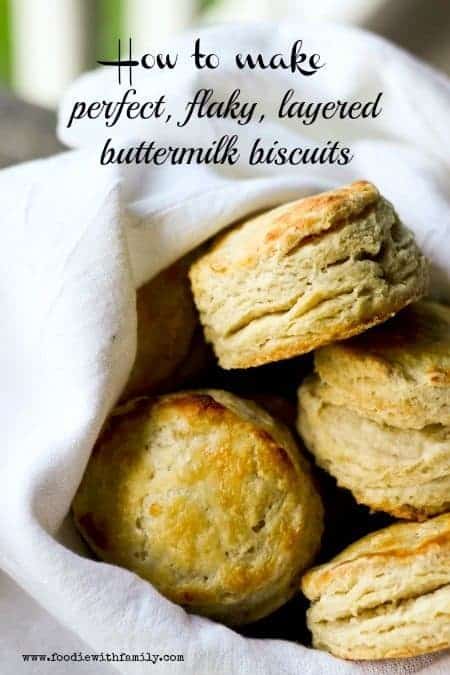
There are times when nothing but a biscuit will do. Drop biscuits are okay; they can fill in the gaps when you are desperate and short on time.
But most of the time, what I’m really and truly hankering for is a lofty, perfect, flaky, layered-from-top-to-bottom, golden brown, moist, golden brown, and delicious buttermilk biscuit. I’m talking about the kind where you can split it in half with your fingers and slather with cold butter and strawberry jam or cover with sausage gravy.
My homemade buttermilk biscuits were always really good… My grandma’s from Arkansas, folks, and she’s an amazing cook and it was her recipe I always made.
Then I learned a few techniques after attending a King Arthur Flour traveling baking demo (and later their Blog & Bake event), that turned my biscuits into the most perfect flaky layered buttermilk biscuits. My Perfect Flaky Layered Buttermilk Biscuits are now the One Biscuit to Rule Them All.
What are these magical techniques? I’ll summarize first.
If these sound fussy, I’ll explain why they make a difference further up and further in! (Name that reference!)
How to Make Buttermilk Biscuits
- Use COLD butter. Do not soften it at room temperature at all.
- Cut your butter into both pats and cubes before working them into the flour.
- Use your hands to work in the butter. Don’t use knives, forks, a pastry cutter, or a food processor.
- Don’t add too much buttermilk. It’s easier to add more later than it is to take excess out.
- Be gentle!!! Don’t overwork or manhandle the dough. Stay relaxed. Biscuits are happy food!
- Use a sharp biscuit cutter. Don’t use a jar, juice glass, or tea cup unless the edge is sharp enough to hurt your lip when you drink from it.
- Push straight down when cutting biscuits. Don’t spin or twist the cutter. Straight down and straight back up!
- Get as many biscuits out of the first cutting as you can. Each subsequent re-rolling and cutting of the dough yields tougher and tougher biscuits.
- Don’t crowd the pan. Make sure each biscuit has room to grow!
Those are the rules. Now, let’s break this down a little more…
Homemade Buttermilk Biscuits
I am not kidding you when I tell you one of the main keys to perfect biscuits is cutting your butter two different ways. When you read through the recipe, it will be obvious that the photos show a double batch here. Because BISCUITS!
Notice that I cut half of the SUPER COLD butter into super thin pats and half into long quarters (or batons) and then crosswise into cubes. There is a scientific reason to this.
You don’t want homogenous pockets or ‘chunks’ of butter in your biscuit dough. Smaller pieces yield tender dough, larger, flatter pieces yield flakiness.
Both of those traits are prized in biscuits. Starting with the butter in two different shapes and sizes helps yield that desired final product.
Using cold butter is crucial, too. Cold butter melts when it’s in the hot oven rather than when it’s being worked into the flour.
The longer it takes to melt, the better… That helps create the layers, too, in our perfect Homemade Buttermilk Biscuits.
Because this recipe uses self-rising flour, you don’t have to worry about anything other than measuring said flour into a nice, large mixing bowl. Into the flour goes the butter.
Now, drop your finger tips into the flour and butter and pull apart the butter pieces while tossing them into the flour. Don’t use the palms of your hands because those radiate heat and that melts butter which makes tough biscuits.
TOUGH BISCUITS. It sounds like an insult, doesn’t it?
Here’s a little video my 13 year old helped me make to show you what I mean years ago. Please enjoy the squawking in the background.
This is a real home with real children who eat the real food I share. They’re especially fond of biscuits.
This brings me to an important point.
Why should I use my hands to work the butter into my homemade buttermilk biscuit dough?
There’s a simple reason for this; it’s because you literally get a feel for how the dough is behaving.
When your hands are in the dough, you know when there are pieces that are too big. You also know when it will or won’t hold together, and you know you’re not beating the tar out of it which would yield TOUGH BISCUITS.
And I’m also not kidding when I tell you that your dough will look a little shaggy -okay, a lot shaggy- when you turn it out of the bowl. In fact, if you’ve not had success with biscuits before, you’re quite likely to think you’ve gone dreadfully wrong and that I’m crazy.
You’re going to be tempted to add a lot more buttermilk, but resist! Don’t do it! Trust me!
It’s time to pat out and fold the dough. That’s how we get all the lovely layers.
Here’s the method:
Slide both hands under one side of the dough (at about 9 o’clock if you think of the dough as a clock face), lift it up, and fold it over the other side at 3 o’clock like you’re closing a book. Again, pat the dough round out into a 2-inch thick rectangle.
This time, slide your hands under the bottom of the dough at 6 o’clock and fold it up toward 12 o’clock. Repeat the patting into a 2-inch rectangle, folding from 9 o’clock to 3 o’clock, patting, then folding from 6 o’clock to 12 o’clock.
Each time you do this, the dough should hold together just a little better. Onto rolling the dough!
Just like every other step, use a light hand when rolling the dough. It shouldn’t take much effort to roll it out.
You have a couple of options for cutting the biscuits. You can either use a nice, sharp, open topped biscuit cutter or a knife.
Either way, you will push the cutter or knife straight down toward the counter. Do not twist the cutter or saw the knife back and forth because that will mar the layers you worked so hard to achieve and keep the biscuits from rising high.
Make sure you don’t crowd your biscuits on the pan. They won’t have a chance to rise and have those gorgeous layered sides if you do. With so many do’s and don’ts in this recipe, I’m happy to say I have an optional step for you.
If you’d like them to be a pretty, glossy brown on top, you can brush them with more buttermilk (as I always do). If you prefer a rustic, flour dusted look to the top of your Perfect Flaky Layered Buttermilk Biscuits, omit that step. It’s just a matter of personal preference.
Finally, I have to tell you… this makes a lot of Perfect Flaky Layered Buttermilk Biscuits. It does.
It even makes more than our Viking horde should eat in one meal. (That’s not to say we haven’t eaten the whole shooting match at once, but I recognize that’s a little excessive.)
When I’m feeling virtuous, I freeze half of the unbaked batch for later meals. Sometimes, when I’m really on the ball, I just whip up a batch of dough, cut out the biscuits, and freeze all of them.
Are you wondering whether they’re as good when they’re baked after having been frozen? I don’t blame you if you are.
I offer proof. The Homemade Buttermilk Biscuit on the left was made from fresh biscuit dough.
The biscuit on the right was from pre-cut biscuits that were frozen for a week prior to baking. Both are fanastic, moist, flaky, and layered top to bottom with fabulous biscuit goodness.
Would you like to know something I’ve discovered? The frozen ones, in my experience, puff up a little higher than the fresh ones.
I love having frozen biscuits in the oven for busy nights or unexpected dinner guests. Now, anyone want a Homemade Buttermilk Biscuit?
Cook’s Notes
- There is going to be a little give and take on yield, but if you use a 2-inch round cutter, you should get about 24 Homemade Buttermilk Biscuits from this recipe.
- Feel free to cut them into squares if you’d like to reduce the work and waste!
- This is a case where you really want to use real cultured buttermilk. There are a lot of times when ye olde vinegar-mixed-with-milk substitute will work, but this is not one of them.
Use These to make Buttermilk Biscuits
Connect with Foodie with Family
facebook | pinterest | instagram | twitter
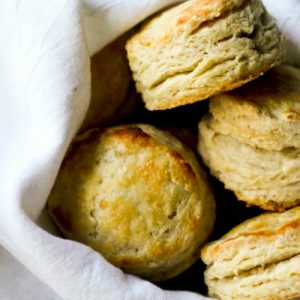
How to Make Buttermilk Biscuits
Rate RecipeIngredients
- 4 cups self-rising flour 1 pound by weight
- 1/2 cup very cold butter 1 stick or 4 ounces by weight
- 1 1/3 cups buttermilk plus extra if needed and for brushing
- all purpose flour for dusting the work surface
Instructions
- Preheat oven to 425°F. Add the self-rising flour to a large mixing bowl.
- Cut the stick of butter in half. Cut one half in 4 batons lengthwise, then cut across the batons to create small cubes. Cut the other half of the butter into pats as thin as you possibly can. Toss the cubes and pats of butter into the flour using just your fingertips so that they are fully coated with flour. Then, one piece at a time, quickly rub each pat and cube of butter between your fingers like you are rubbing dried glue off of your fingers. Continue doing this until all the butter has been rubbed into uneven pieces no larger than peas.
- Pour all but about 2 tablespoons of the buttermilk around the inside edges of the bowl. Reserve the buttermilk in case it's needed. Use a sturdy spoon, silicone or rubber spatula, or flexible dough/bench scraper to toss the buttermilk into the butter and flour mixture until a scrappy dough starts to form. If the mixture is still very dry, toss in the remaining buttermilk. Pick up a small amount of the dough and squeeze it in your hand. If it holds together you're ready to proceed. If most of the mixture is still very dry, you can add buttermilk -1 tablespoon at a time- until the dough holds together when squeezed.
- Dust a clean work surface with all-purpose flour (NOT self-rising here) and scrape the dough out into a pile. Quickly and gently use just enough pressure to pat the pile of dough into a rectangle that is about 2-inches thick. As you're patting it out, gently incorporate any crumbling edges back into the dough mass.
- Slide both hands under one side of the dough (at about 9 o'clock if you think of the dough as a clock face), lift it up, and fold it over the other side at 3 o'clock like you're closing a book. Again, pat the dough round out into a 2-inch thick rectangle. This time, slide your hands under the bottom of the dough at 6 o'clock and fold it up toward 12 o'clock. Repeat the patting into a 2-inch rectangle, folding from 9 o'clock to 3 o'clock, patting, then folding from 6 o'clock to 12 o'clock. Each time you do this, the dough should hold together just a little better.
- Rub a rolling pin with flour and very gently roll out the dough into any shape you'd like, but aim for 3/4-inch to 1-inch thickness. Flour a sharp round or square open-topped biscuit or cookie cutter. Cut straight down into the biscuit dough, not turning or spinning the cutter as you cut. Cut the biscuits as closely together as you possibly can, minimizing any excess between them. If you do not have a sharp biscuit cutter, use a sharp knife and cut straight down into the dough forming squares.
To Bake Right Away:
- Transfer the biscuits to a greased or parchment lined cookie sheet, brush the tops of the biscuits with buttermilk. Put the tray in the oven and bake for 8-12 minutes, rotating the pan front to back halfway through baking. When they are golden brown, delicious looking, and lofty. Remove them from the oven. Let stand at least 2 minutes before eating or transferring to a towel lined bowl.
To Freeze Biscuits for Later:
- Transfer the unbaked, cut biscuits to a parchment lined cookie sheet. Cover lightly with plastic wrap and stick the cookie sheet in the freezer. When the biscuits are frozen solid, stack them in a resealable freezer bag, label the bag, and keep frozen until needed, or for up to 3 months. If you store them longer than that, they will still be bake-able after that, but not quite as high-rising and tasty!
To Bake the Frozen Biscuits:
- Preheat the oven to 475°F. Line a cookie sheet with parchment paper. Arrange the frozen biscuits on the sheet leaving at least 2 inches between each biscuit. Brush the biscuit tops with buttermilk and bake the biscuits for 5 minutes. After 5 minutes, lower the heat to 425°F and continue cooking for 10 minutes or until the biscuits are golden brown, delicious looking, and lofty! Remove them from the oven and let stand at least 2 minutes before eating or transferring to a towel lined bowl.
Nutrition
Nutritional information is an estimate and provided to you as a courtesy. You should calculate the nutritional information with the actual ingredients used in your recipe using your preferred nutrition calculator.
did you make this recipe?
Make sure to tag @foodiewithfam on Instagram and #hashtag it #foodiewithfamily so I can check it out!
Are you looking for more delicious options to fill your freezer and pair with your Buttermilk Biscuits? Try this!
Turkey Breakfast Sausage comes together in a flash and is easily stored in the freezer using a clever method that lets you pull single patties from the bulk package!
You can also ladle copious amounts of this terrific Classic Sausage Gravy over the Perfect Flaky Layered Buttermilk Biscuits and be a very happy human indeed!
This post originally published on October 26th, 2013, updated notes in November 2015, July 2017, and March 2021.
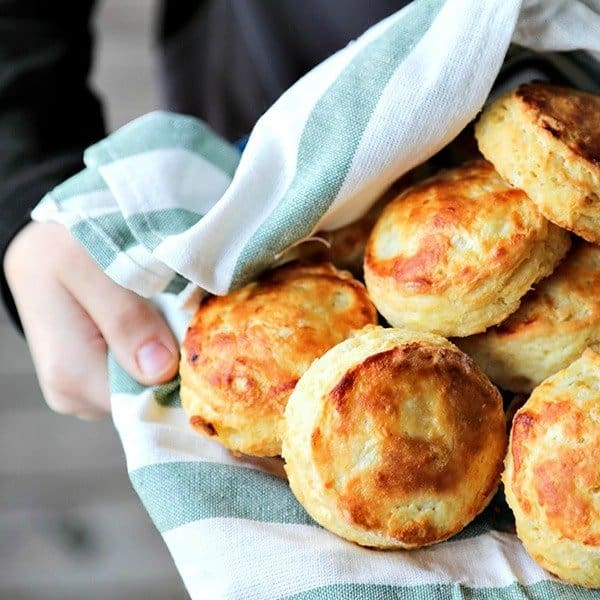
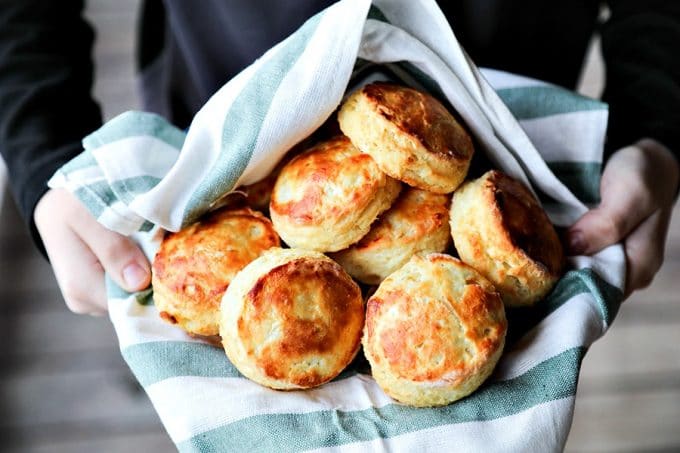
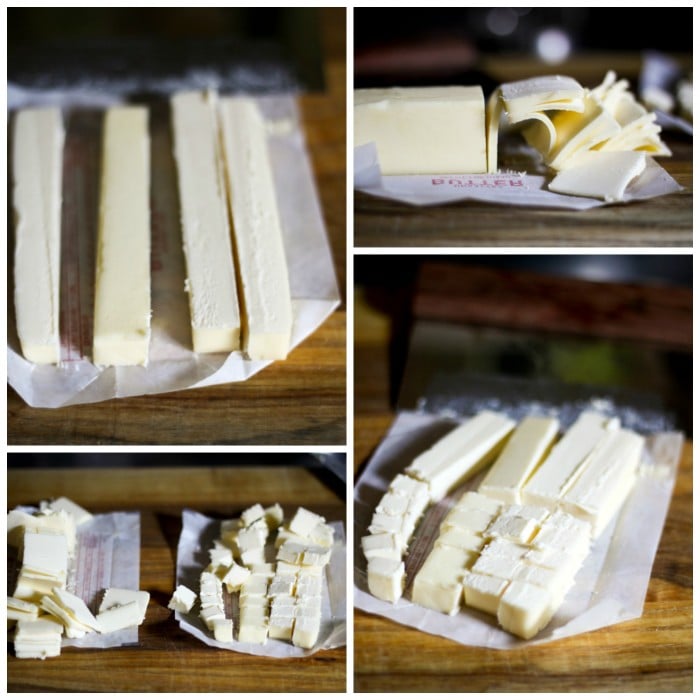
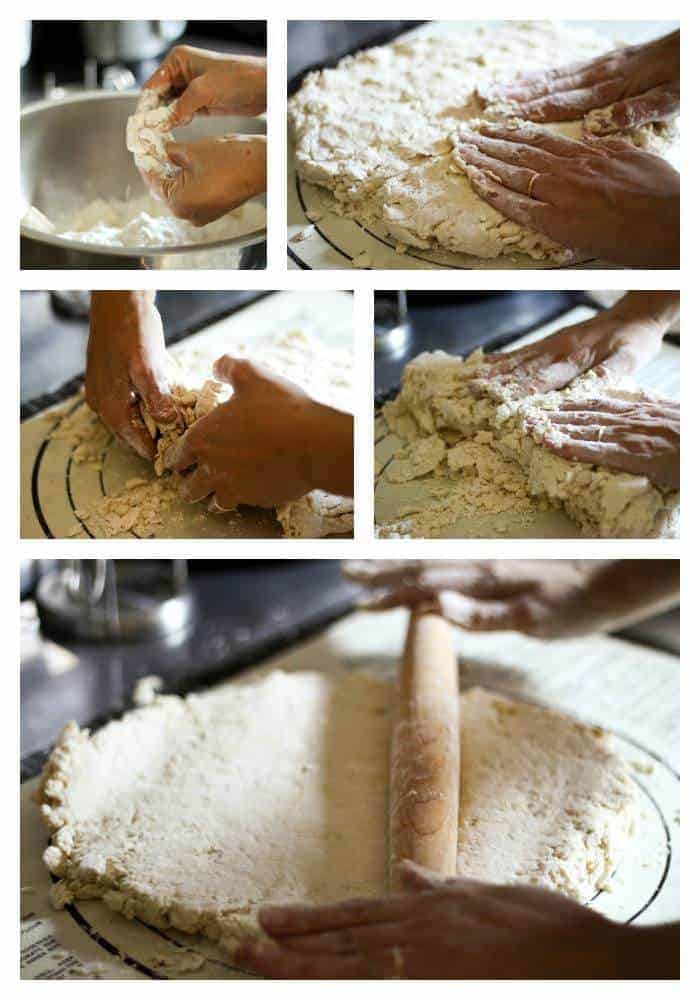
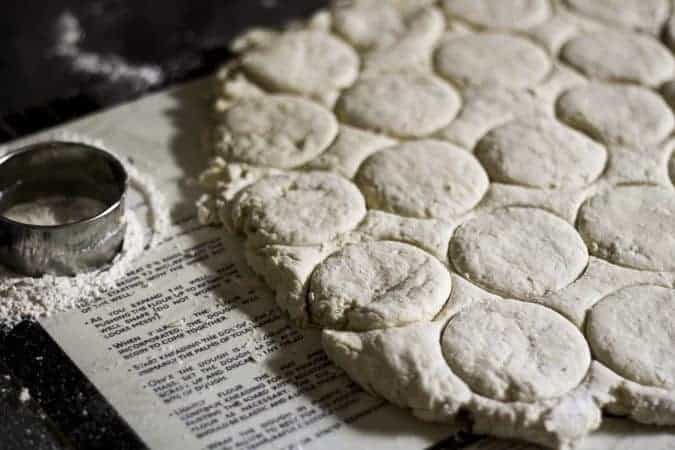
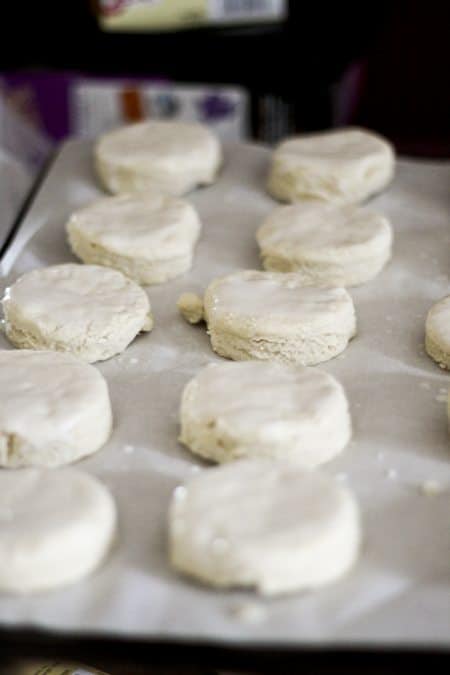
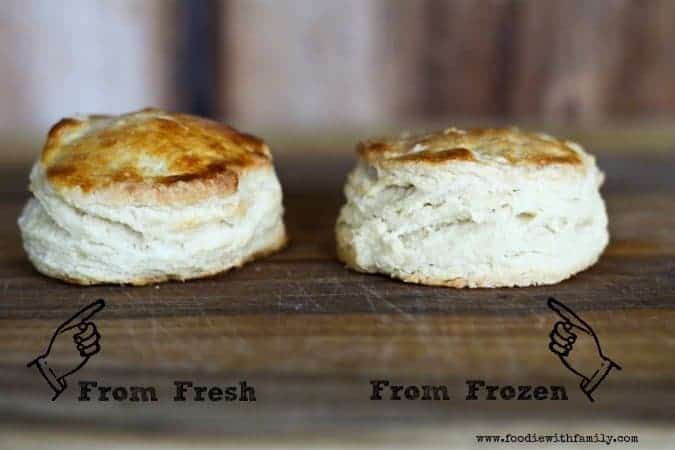
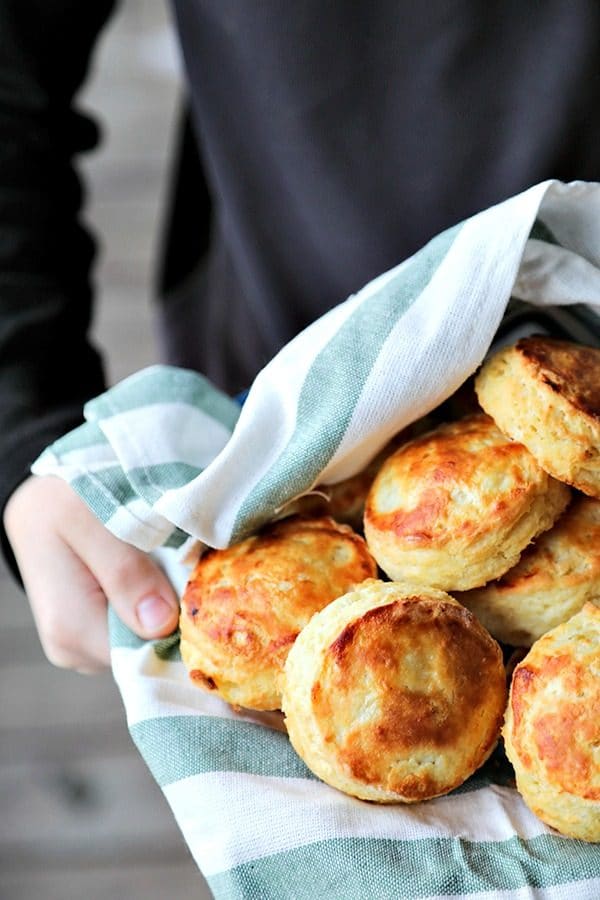

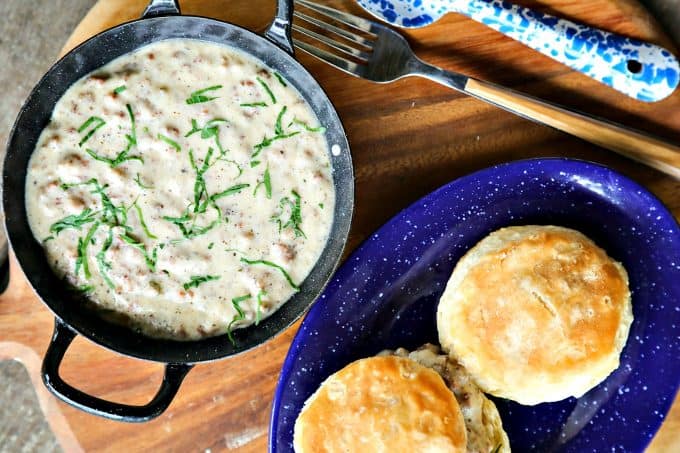
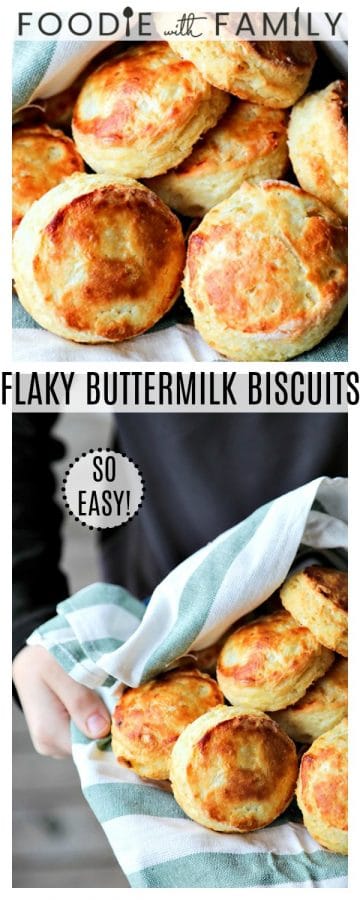



Reader's Thoughts...
Ckim says
The techniques and hints shared here really helped me and I made mind-blowing biscuits (different recipe though, and it had a lot more butter).
I followed the advice in the tutorial regarding using less buttermilk than the recipe listed, and let the dough be “shaggy” and the shags did become incorporated as I did the dough folds and turns. I’m glad I actually listened.
Also, I froze my butter, both before cutting it into the pieces described and after. Worked great.
The recipe I used was Chef John’s Buttermilk Biscuits on the Allrecipes site. I’m sure this recipe will be great too, but I can’t comment on that. Thanks for taking the time to write this up and to help others.
Butts Giraud says
Rebecca…made your recipe yesterday and froze the final product to serve to a great friend who was
visiting….they were so good,fluffy and flakey ……I followed it to a T …… They were the best ever! Thank you! It was nice to know I could freeze the dough before baking the next morning! It’s a winner for sure.!
Donna Rice says
Hi Rebecca,
I was looking to find out how to freeze biscuits ,came across your website. I’ve been cooking the flakier biscuits for a while. Appreciate information about not twisting when cutting the dough. Will be buying a dough scrapper. I will give the less butter a try. I use one stick to a cup. Sounds like over kill, but they turn out great. Enjoyed the tutorial . You can always learn from others. Thanks
Rebecca says
Thank you so much, Donna! I’m not sure there’s such a thing as too much butter. I bet those are delicious! 😀
Connie says
Can you tell me what the item you used to mix/turn your dough in the video is called? It appears to be flexible plastic and makes the job look easy. Thanks.
Rebecca says
Sure thing, Connie. Here is a link to the dough scraper I use. You’re right that it makes the job significantly tidier and easier!
Elle says
Biscuits are supposed to have a slight crust on the outside and be fluffy inside like a cloud. Not in layers like you get out of a can.
Rebecca says
Wow, Elle. Please note that the recipe is for flaky biscuits. I love a good, old-fashioned regular biscuit, but these are pretty darned good. I hope you give them a try some day. You may be pleasantly surprised.
Amy says
My parents like biscuit dough as topping for pies and other things. Is it possible to freeze the dough as a whole rather than cutting in pieces? Would it roll out ok? Just want to know your opinion?
Rebecca says
Hmmmmm. I haven’t tried it, Amy! I’d love to know the result if you guys give it a shot!
Zack says
Thanks for the awesome recipe! The only problem was when I made these they didn’t really brown on the tops. Any ideas? Maybe I brushed too much buttermilk?
Rebecca says
That is quite likely the issue, Zack! I love the flavour the buttermilk gives it, though, so I go for it abundantly every time. 😀
Zack says
Gotcha, will use a bit less next time. Appreciate the response!
Tori M says
I want to try these ASAP! Planning on making em extra fancy with whole wheat pastry flour though, how much baking powder should I add? 🙂
Rebecca says
Hi Tori- This recipe is geared to be made with self-rising flour. There are quite a few resources available to help you determine how much whole wheat pastry flour and baking powder you should add. I recommend checking King Arthur Flour’s website!
Helen Cato says
For that amount of flour, 2TBS of baking powder, and 1/2 tsp. of baking soda.
Melanee says
I found this dough rather dry. I have made biscuits many times and these were so dry and hard to get the dough to stick together. Flavour was fine. Not a super fluffy biscuit. They did rise like hers, but it was lacking even with salt. I did two separate trials on this, evening adding 1 tbsp of sugar to one batch. I just found the dough terribly dry -needs at least 1/3 c more buttermilk in order for the dough to hold together better.
Rebecca says
Hi Melanee- In the recipe, the buttermilk amount given carries the qualification “plus extra if needed” because everyone measures flour differently, or uses different brands of flour, and you have the added variables of relative humidity, temperature, and elevation. While the amount listed may have been perfect for me, it is entirely likely that you may have needed extra buttermilk to compensate for whatever variances your environment had from mine. I appreciate you weighing in with your concerns and remain confident in the recipe based on my results and the results of many folks who have tried the recipe.
Jessica says
Only one stick of butter for 4 cups of flour? Most recipes are doing one stick for two cups flour- is this correct? Even in the butter pics, it looks like two sticks of butter- one in pats and one in the batons. HELP! Thanks!
Rebecca says
Hi Jessica- The recipe is correct; one stick of butter to 4 cups of flour.The reason the photos show the two sticks of butter is that I was making a double batch when I photographed the process. Good eyes, though! I appreciate the question!
Jessica says
Is that enough butter?! Ack!
Rebecca says
It is plenty of butter. If you are concerned, look at all the comments of the folks here on this post who have made it successfully!
Jessica says
The biscuits were AMAZING!!!!! Thank you soo much!!!! A magical and easy recipe!
Elania says
I’ve made eight batches of this recipe since 11/19, practicing and experimenting (could I make them a day ahead of Thanksgiving and keep them in the fridge? – no, they bake up a bit tough and don’t rise; do I have to glaze them with buttermilk or butter?- no, they’re still pretty delicious without; will my biscuits actually rise after freezing them?-yes, perfectly; do I have to use my fingers or can I use a pastry cutter?-pastry cutter worked great for me…) I found that folding the dough 4-6 times was more than sufficient… I have 60 of these babies in the freezer right now, ready for Thanksgiving tomorrow. The kids love them! Thanks for the tutorial!!
Rebecca says
I love hearing about your various experiments with this Elaina! I am so glad you confirmed my conclusions about the frozen dough pucks baking up beautifully. You are very welcome for the tutorial. Happy Thanksgiving!
Diane Bouska says
Hi Rebecca
These sound wonderful. I have one question..how many times do you fold the dough?
thanks!
Rebecca says
Hi Diane- I can’t give you a hard and fast number, but rather I suggest you fold it at least 4 times, but up to 10. The goal is to get the dough to hold together without being fully smooth. What you’re really going for is a layered dough that doesn’t have clumpy bits falling away at the edges.
Diane Bouska says
Good enough! Thank you!
Will says
I love flaky busicuts and I love flavor biscuts, but I have never had a flaky flavored biscut. Do you think this receipe will work well with add-ins, like cinnamon raisin, pumpkin spice, cheddar bay? How would I go about adding in flavors to keep the flakiness?
Rebecca says
Hi Will- Great questions! I think some of the combos would work, but some might not. For instance, a cinnamon biscuit might work, but I think the raisins might play dirty pool with the flaky layers. I think if you are doing cinnamon or pumpkin spice or bay, you would whisk the spices into the dry ingredients before you added the fat. I would say the cheddar would probably need to be tossed into the mix AFTER the fats are cut in but before the buttermilk. The reason I think the cheese would work but raisins wouldn’t is because the cheese would melt in whereas the raisins will maintain their shape. ALL THAT BEING SAID, I haven’t tested any of those ideas, so take them with a grain of salt! 😀
Eric says
I have dry buttermilk powder. You mix it with your flour and then add water (or regular milk) 4 to 1 water to powder. Will that work as well? Is there any alteration to the recipe I would need to make?
Thank you.
Rebecca says
Theoretically, it should work, Eric, but I haven’t tested it, so I’m hesitant to give advice on it. The only trick you’re going to run into is that there’s a little give on how much liquid buttermilk you add based on the amount the flour mixture absorbs. Since you’re tossing the powder in with the flour before adding the fats and liquids, you may end up with a more pronounced or less pronounced buttermilk flavour based on how much liquid you end up adding.
Megan says
I had given up on biscuits. I have tried more than 10 recipes never getting the biscuits I had in my mind. When I told a friend I wanted flaky biscuits she told me only the processed ones can do that. I knew that wasn’t the case. But could never get biscuits to do that. Your tips and recipes are going to be in my family for generations. I can’t wait to make them this Thanksgiving and get everyone addicted. Thanks for sharing the tips and bringing my family a wonderful new tradition.
Rebecca says
Megan,
You made my day with that comment! Thank you for taking the time to let me know that this tutorial helped you! There’s nothing quite like a flaky biscuit for sopping up gravy!
catherine says
This is my new method. I have a bag of frozen biscuits in the fridge. I can’t find a large sharp biscuit cutter! Any advice? The largest I can find is 3″. Thanks!
Sarah says
Holy yum! These were PERFECTION! Thank you for providing me with my new go-to biscuit recipe! 🙂
Rebecca says
YAY! Thanks Sarah!
Gwen Corder says
While I consider myself quite the accomplished biscuit maker (after almost 30 years of trial and error), I am always open to new ideas. I stumbled on this post while looking for the proper method to freeze unbaked biscuits. I can’t wait to try your method – bravo!
Ann R says
I just made biscuits, but they did not rise, and that is why I sought help right now not too expeirnced Thank you. Will do yours Saturday, fallowing your video. Thanks again.
Kim says
I’m not much of a baker, but want to make homemade biscuits to serve at Christmas. This is a great tutorial! Someone already asked but it wasn’t answered – roughly how many does this recipe make? You just say “a lot” but I’m trying to gauge the quantity.
Rebecca says
If you use a 2-inch cutter, this recipe should yield about 2 dozen!
Kim says
Thank you! I’ll need to 1.5 or double the recipe – my extended family can put away a lot of biscuits. 🙂
Rebecca says
Oh gosh. I almost always double it 😀 My guys can put away ridiculous amounts of food!
Lori says
First batch is just out of the oven. Trying these out to make for Thanksgiving. Did not have a sharp cutter so opted for a knife and square biscuits. NEVER saw a biscuit rise so high. Wonderful!! Thank you for the tutorial it really helps with the “shaggy” instructions.
I always have the same question. Unsalted butter?
Thank you